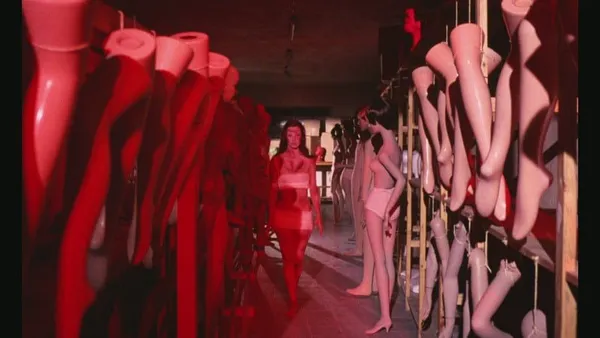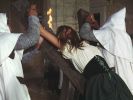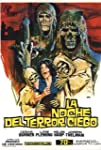Eye For Film >> Movies >> Tombs Of The Blind Dead (1972) Film Review
Tombs Of The Blind Dead
Reviewed by: Jennie Kermode

Made in the wake of Night Of The Living Dead but before the craze for horror films that dominated European cinema for much of the Seventies, Amando de Ossorio's vividly realised tale of terror would prove hugely influential. It has recently ben restored by Synapse Films and it screened as part of the 2021 Fantasia International Film Festival in all its original glory. Though aspects of its story stretch credulity even within the bounds of fantasy and it is at times spectacularly silly, it is delivered with rare style and panache. There is much here to admire and to tremble at.
The story hinges on three twentysomethings who decide to take a trip together. Virginia (Maria Elena Arpon) and Roger (Cesar Burner) are best friends. Betty (Lone Fleming) is Virginia's former boarding school roommate, whom they chance upon at a swimming pool. Sparks start to fly immediately between Betty and Roger but, girls' boarding schools being what they are in the minds of 20th Century male European film directors, she and Virginia have a secret history. Unable to cope with losing Betty again, Virginia jumps off a slow-moving train and strikes off across the fields. The train driver's son wants to stop for her. "No," his father cautions him. This is a place where they must never stop.

His concern, it emerges, has to do with a ruined abbey at Berzano once inhabited by Knights Templar. Not content to make use of the bizarre things this sect actually did, de Ossorio has enthusiastically elaborated on their history, inventing his own bloody ritual as a consequence of which they rise from their tombs undercover of darkness to seek out human blood. Naturally, that's not good news for young women all alone with no knowledge of the area. When Virginia's maid reports that she didn't make it home, Betty and Roger go looking for her, but they're not exactly safe either. Meanwhile, the local police investigate, but encounter unexpected obstacles.
“She was asking for it,” says a coroner’s assistant, dealing with a curiously marked body in the local morgue. “Going around flaunting herself like that. It’s as if they want to be bitten.” It's a cute observation on attitudes which would be addressed far less critically in later genre works. Protecting herself against undead knights is, after all, not usually high on a young woman's list of concerns. Nothing much seems to deter these knights anyway,. They're slow, but they ride horses (the equestrian scenes are some of the most impressively shot in any film). They're blind, but they hunt by sound. Heroines who conform to the default behaviours of the era, holding up their hands and shrieking, are easy prey, but even someone with the sense to be silent might be given away by the beating of a tell-tale heart.
The slow but determined movement, the horses, the long robes and the elements of ritual all combine to give these knights a kind of elite patriarchal authority which is, perhaps, the real reason why women feel helpless on encountering them and working class people dare not try to intervene. It's as if they are perceived to have a right to the abbey and its surroundings; as if the past must be kept separate not just temporally but geographically, given its space in order to keep it from intruding on the present. Any provocation in the women's clothing may stem not from its perceived scantiness but from the fact it is modern.
Class markers are present throughout, along with other signifiers of hierarchy. Betty works as a manufacturer of mannequins in a studio which, we are told, is overlooked by a factory making neon signs - an excuse for the director to flood the space with blinking lights in unnatural colours as a threatening figure slips between the rows of artificial ones. It's her assistant, however, who faces the greatest peril. The existential threat represented by the knights only really becomes alarming when upper middle class people are threatened, something which the film builds towards.
Fans of later European horror will either be charmed or frustrated by the film's coy attitude towards nudity. Women frequently strip down to their underwear without much reason and there is a good deal of very deliberate teasing, but the only breasts we see are obscured by artificial latex tissue. This is present partly for the sake of special effects, but in close-up scenes were we see the knights licking blood from skin - which could be any patch of skin - latex stands in instead, giving the whole thing a weirdly fetishistic quality. Similarly disconcerting is the fact that almost all the living characters smoke like chimneys, to the extent that they seem unlikely to live long lives in any event, and certainly don't seem fresh and youthful in the way that the director presumably intended.
These curious details aside the film is brilliantly staged, with some truly stunning set pieces. De Ossorio seems fully in control at all times, which makes it easier to accept the supernatural elements. He also makes dazzling use of colour without exceeding the boundaries of what's believable (except, of course, with that de rigeur bright scarlet blood). If you have an interest in the history of horror cinema, or if you simply enjoy the visual language which would subsequently be adopted by the masters of giallo, this film is a must see.
Reviewed on: 08 Aug 2021
















